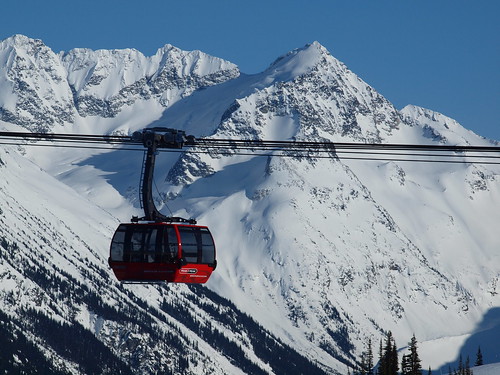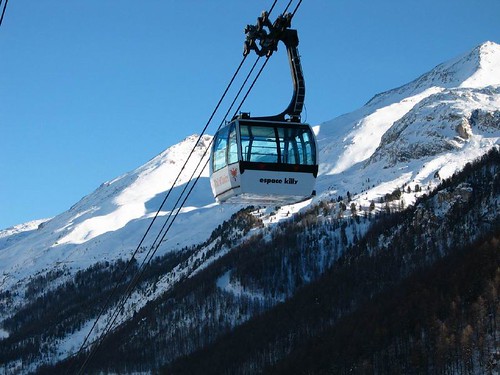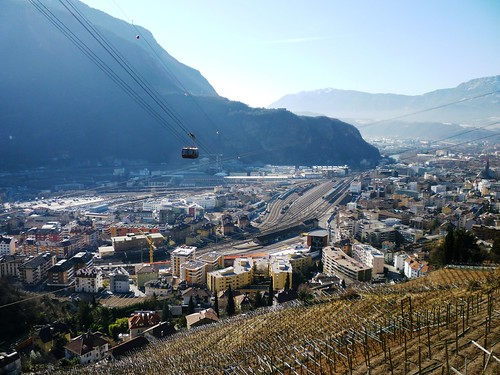- Image by jonwick04.
One of the rarest and most exciting (at least from an urban perspective) of all aerial cable systems is the 3S.
The term 3S derives from the phrases drei Seile or drei Seil in German which translate directly to three ropes or three rope in English. The term is used because 3S systems use two support cables and a one single propulsion cable (or ‘ropes’ as it is commonly used). This is a little bit tricky and confusing, however, because there exist Aerial Trams that also use two support ropes and one single propulsion rope. So what gives?
Here’s what gives: The difference between an Aerial Tram and a 3S system all boils down to detachability. Whereas Aerial Trams are exclusively shuttle-based in nature (and are therefore not detachable), 3S systems are continuously circulating detachable systems. This makes a huge difference.
While both systems have outstanding wind tolerances exceeding 100 km/hr, and both can operate at speeds up to ~30 km/hr, the 3S’s detachability allows for LT1M wait times and maximum capacities up to six times higher than an Aerial Tram (up to a current maximum of 6,000 pphpd). Cornering and intermediary stations are also possible with 3S, something Aerial Trams are not – for all intents and purposes – capable of.
It’s best to think of a 3S as a hybrid of a Gondola system and an Aerial Tram system. With vehicle sizes of up to 35-40 people, they’re much larger than standard Gondolas, but more compact than Aerial Trams. In fact, some references to 3S demonstrate that some view the technology as nothing more than a high-capacity BDG system (we’ll save this bizarre matter for another day’s post).
The most captivating of all the 3S’s features is its ability to span huge distances without towers. In the case of the Whistler-Blackcomb Peak2Peak, that 3S system spans a 3 kilometer long mountain valley without a single intermediary tower. To do this, however, requires significant sag (or ‘belly’) in the ropes as well as massive tower infrastructure. This is appropriate for complex crossings in mountain settings, but not in an urban environment where more closely set, lower profile towers would be necessary.
The 3S can be on the pricey side, costing between $10-30 million (USD) per kilometer depending on capacity and stations. The Peak2Peak came in at around $12 million per kilometer for a 4.6 km long system, but that is based on a 2,050 pphpd capacity, 49 second wait times and only two stations. A CPT version of a 3S system would likely cost 2 – 3 times that, but that would include all civil work, intermediary stations and capacities of 4-6,000.
Given that ski resorts rarely have the capacity needs that a 3S can offer, they are a very rare system in the cable universe. That might change as urban settings look towards CPT and require high speed, high-capacity systems. Currently, however, only three 3S systems exist in the world and all are located in resort settings (though the Rittner’s lower terminal is located in suburban Bozen/Bolzano):

The Peak 2 Peak in Whistler, British Columbia. Built in 2008 by Doppelmayr/Garaventa. Image by TylerIngram.




24 Comments
hi steven, any sources for your 35-to-40 capacities? i’m just familiar with the newest ones up to 35. maximum and a maximum speed of 27 km/h.
I’ve heard that the Bozen system can hold up to 40, but I’ve not got any confirmation of that, no. As for maximum speed, you’ve got to recognize that just because a resort only uses systems that go 27 km/hr, doesn’t mean it cannot go faster. The nature of urban versus resort almost always kicks in here. My sources within the industry have told me that 35 – 40 km/hr is currently possible. That makes sense because Aerial Trams can go 40 km/hr and a 3S is nothing more than a fusion of Gondola and AT technology.
You do miss one upside of an attached system: smoother ride. At least that is my experience with cable systems I’ve ridden, though I haven’t ridden in any modern gondolas (attached: Pittsburgh Incline, Mandalay Bay Cable Car, detachable: San Francisco Cable Car, high speed chair lifts). With an attached system, the cable smoothly accelerates from zero to whatever the top speed is, then back down to zero. With detachable, the cable always moves at the top speed, and you get very jerky, sudden acceleration by grabbing onto it. Do you think this has something to do with why you see higher top speeds on attached systems? What do you do to make acceleration comfortable when you have a high line speed? Beyond this I really don’t see what would limit a gondola’s speed besides maybe the desire to avoid the sensation of weightlessness as you go over each tower.
Eric,
You might be right that top speeds have higher speeds due to their being attached, but I don’t know. 3S systems that are coming around are capable of speeds that attached Aerial Trams are capable of, which sort of negates the argument you’re making. I’ve ridden a 3S and the “jerkiness” you mention is not present, likely due to the weight of the vehicle compared to something like an old 4 person monocable. I’ve heard rumblings that possible, engineerable top speeds are much higher than what is currently reported, but I can’t confirm or deny it. I’ve been trying to get that answer for a couple months now with no luck. I’ll try and follow-up on this in the future. Maybe a “cable gossip” column once in a while.
speed is the most important relative to size of pillars and station. a station design is gets it’s size by the length of getting out and into the cabin and then and most important: speeding down and speeding up.
this is the only reason for the size of stations, speed and pillars.
i was told the construction on top of each pillars on 3s systems can max out up to 40 m!!!
why? to reach the high speed and big distances on that track – while still being smooth.
easy to compare just take a look at the breaking length a usual tram needs.
i would consider rougher breaks and accelleration to speed up the system a little bit.
I’m having a hard time imagining 100 people boarding these things in one minute. If the cable industry can do that, then I think Southwest airlines would like to license the technology…
Later: Oh, I was thinking of a 2-stop system, with every single person getting on and off at every stop. Maybe you’re thinking of a multi-stop system, where the people come on over a couple of different stops, more like a bus.
Dave,
I know its hard to imagine, but its true. With the new 3S systems, up to 100 people can be processed per minute. Im even hearing rumors that that can be pushed to 130.
Having ridden the Peak 2 Peak inWhistler, I can assure you this is very likely.